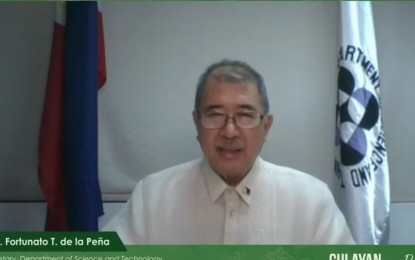
DOST Secretary Fortunato de la Peña (Screenshot from Philippine Council for Agriculture, Aquatic and Natural Resources Research and Development's Facebook page)
MANILA – At least 345 families from 19 communities in the National Capital Region have benefited from the Department of Science and Technology- Philippine Council for Agriculture, Aquatic and Natural Resources Research and Development's (DOST-PCAARRD) urban gardening project, the agency announced Wednesday.
"Metro Manila was the hardest hit by the (coronavirus disease 2019) pandemic. That is why we focused our project there. Who would have thought they could plant in the city and despite living in a small space? Technology made it possible," DOST Secretary Fortunato de la Peña said in a virtual presser.
He said the project, called, "Gulayan sa Pamayanan", is the DOST's way to help address food shortage and loss of livelihood.
"It is one of the DOST's ways to help achieve food security. We thank the 19 communities for their cooperation," de la Peña said.
The communities are Muntaparlas (Barangay CAA, Las Piñas; Barangay BF Homes, Phase 3, Parañaque City; Don Bosco, Parañaque City; Doña Rosario Heights and Paradise Garden group of Sucat, Muntinlupa City; and GAD, MCTI, Putatan, Muntinlupa City), Pamamazon (Barangay 412, Sampaloc, Manila; Claro M. Recto High School, Barangay 412, Sampaloc, Manila; and Barangay Pildera, Pasay City), Pamamarisan (Barangay Nangka, Barangay Concepcion THAI, Barangay Concepcion Uno, Fortune, and CEMO of Marikina City), and Camanava (Barangays Pasolo, Balangkas, Tanza 1, and Tanza 2, Navotas City.
Gardening materials and training on enriched potting preparation (EPP) and simple nutrient addition program (SNAP) hydroponics were provided to the residents.
EPP requires recyclable soda bottles as plant pots, a potting medium, coco coir, and the compost soil extract (CSE) that was formulated to provide nutrients to herbs, vegetables, and ornamental plants.
SNAP hydroponics, on the other hand, uses recycled styropor boxes, styro cups, growing media composed of coco peat, carbonized rice hull, sawdust, and fine sand. A nutrient solution is also added.
According to PCAARRD, some 3,950 EPP kits, 2,350 SNAP kits, 180 bags of compost, eight coco coir net greenhouse, 1,000 liters of CSE, 100 sets of SNAP solutions, and 10 packs of plastic lining were distributed.
A total of 250 beneficiaries were trained.
"Because of these, they were able to get safe and nutritious vegetables that helped them prevent malnutrition. They used the vegetables for their own consumption, while the extras were sold for extra income. Some were also shared to nearby barangays," de la Peña said.
The DOST chief is urging other government agencies to do projects similar to the "Gulayan sa Pamayanan". (PNA)
"Metro Manila was the hardest hit by the (coronavirus disease 2019) pandemic. That is why we focused our project there. Who would have thought they could plant in the city and despite living in a small space? Technology made it possible," DOST Secretary Fortunato de la Peña said in a virtual presser.
He said the project, called, "Gulayan sa Pamayanan", is the DOST's way to help address food shortage and loss of livelihood.
"It is one of the DOST's ways to help achieve food security. We thank the 19 communities for their cooperation," de la Peña said.
The communities are Muntaparlas (Barangay CAA, Las Piñas; Barangay BF Homes, Phase 3, Parañaque City; Don Bosco, Parañaque City; Doña Rosario Heights and Paradise Garden group of Sucat, Muntinlupa City; and GAD, MCTI, Putatan, Muntinlupa City), Pamamazon (Barangay 412, Sampaloc, Manila; Claro M. Recto High School, Barangay 412, Sampaloc, Manila; and Barangay Pildera, Pasay City), Pamamarisan (Barangay Nangka, Barangay Concepcion THAI, Barangay Concepcion Uno, Fortune, and CEMO of Marikina City), and Camanava (Barangays Pasolo, Balangkas, Tanza 1, and Tanza 2, Navotas City.
Gardening materials and training on enriched potting preparation (EPP) and simple nutrient addition program (SNAP) hydroponics were provided to the residents.
EPP requires recyclable soda bottles as plant pots, a potting medium, coco coir, and the compost soil extract (CSE) that was formulated to provide nutrients to herbs, vegetables, and ornamental plants.
SNAP hydroponics, on the other hand, uses recycled styropor boxes, styro cups, growing media composed of coco peat, carbonized rice hull, sawdust, and fine sand. A nutrient solution is also added.
According to PCAARRD, some 3,950 EPP kits, 2,350 SNAP kits, 180 bags of compost, eight coco coir net greenhouse, 1,000 liters of CSE, 100 sets of SNAP solutions, and 10 packs of plastic lining were distributed.
A total of 250 beneficiaries were trained.
"Because of these, they were able to get safe and nutritious vegetables that helped them prevent malnutrition. They used the vegetables for their own consumption, while the extras were sold for extra income. Some were also shared to nearby barangays," de la Peña said.
The DOST chief is urging other government agencies to do projects similar to the "Gulayan sa Pamayanan". (PNA)
